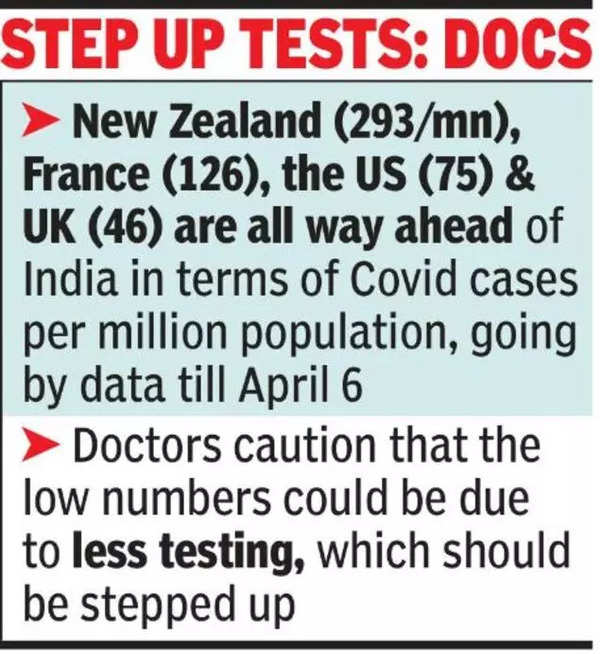- News
- India News
- At 2/million, India’s Covid load fraction of global numbers
Trending Topics
At 2/million, India’s Covid load fraction of global numbers

MUMBAI: The surge in Covid cases in India may not be as bad as the outbreak in some other countries such as New Zealand, France or South Korea, according to population-based data.

India has only two cases per million (10 lakh) population, which is a fraction of the number in many European and American countries. As per data for the week ending April 6, available on ourworldindata.org, the rate in New Zealand is 293 per million population, France witnessed roughly 126 cases per million last week, and the corresponding number for South Korea is 163. Data analysed on April 6 showed that the United States had 75 cases per million population while the United Kingdom had 46.

“We are witnessing an increase in cases, and there are patients getting admitted to hospitals, but, in terms of numbers, we seem to be better off than other countries,” said infectious diseases specialist Dr Tanu Singhal from Kokilaben Ambani Hospital, Andheri.
However, she added that the statistic could be a reflection of the inadequate testing in India. If India conducted 22 lakh tests a day in August 2021, the number stands at 1 lakh at present.
Dr Rahul Pandit, who heads the intensive care department of Sir H N Reliance Hospital, said people are not getting themselves tested. “And those who do, have a mild form of the illness,” said the doctor. Officials in Maharashtra’s public health department said that on most days, the amount of testing is as per World Health Organisation’s directive of 140 tests per million population. The central government has, however, directed all states to step up testing, especially using the RTPCR technology instead of the rapid antigen testing (RAT).
Singhal said the main reason for the all-round panic in India could be that Covid had virtually disappeared here. “Many countries kept registering cases while we had a negligible number of Covid cases,” she said. During the July 2022 surge, which was noticed in metros such as Mumbai and Delhi, people were not very sick and hospitalisations didn’t rise.
The ongoing Omicron outbreak, driven by the latest of its 600 sub-variants named XBB.1.16, is different: “This time around, the cases are not doubling within a day or so,” she said. The case presentation is also different: people have a terrible throat infection that lasts for 10 to 14 days and the CT scans of the severely ill show shadows in different locations than seen in the preceding waves.
Dr Rahul Pandit said that as long as the Omicron variant and its sub-lineages are in circulation, there should be no major cause for worry. “We need to be vigilant, especially with vulnerable populations,” he said.

India has only two cases per million (10 lakh) population, which is a fraction of the number in many European and American countries. As per data for the week ending April 6, available on ourworldindata.org, the rate in New Zealand is 293 per million population, France witnessed roughly 126 cases per million last week, and the corresponding number for South Korea is 163. Data analysed on April 6 showed that the United States had 75 cases per million population while the United Kingdom had 46.

03:43
'Omicron subvariant circulating, hospitalisation not increased': Mandaviya on India's active Covid-19 situation
“We are witnessing an increase in cases, and there are patients getting admitted to hospitals, but, in terms of numbers, we seem to be better off than other countries,” said infectious diseases specialist Dr Tanu Singhal from Kokilaben Ambani Hospital, Andheri.
However, she added that the statistic could be a reflection of the inadequate testing in India. If India conducted 22 lakh tests a day in August 2021, the number stands at 1 lakh at present.
Dr Rahul Pandit, who heads the intensive care department of Sir H N Reliance Hospital, said people are not getting themselves tested. “And those who do, have a mild form of the illness,” said the doctor. Officials in Maharashtra’s public health department said that on most days, the amount of testing is as per World Health Organisation’s directive of 140 tests per million population. The central government has, however, directed all states to step up testing, especially using the RTPCR technology instead of the rapid antigen testing (RAT).
Singhal said the main reason for the all-round panic in India could be that Covid had virtually disappeared here. “Many countries kept registering cases while we had a negligible number of Covid cases,” she said. During the July 2022 surge, which was noticed in metros such as Mumbai and Delhi, people were not very sick and hospitalisations didn’t rise.
The ongoing Omicron outbreak, driven by the latest of its 600 sub-variants named XBB.1.16, is different: “This time around, the cases are not doubling within a day or so,” she said. The case presentation is also different: people have a terrible throat infection that lasts for 10 to 14 days and the CT scans of the severely ill show shadows in different locations than seen in the preceding waves.
Dr Rahul Pandit said that as long as the Omicron variant and its sub-lineages are in circulation, there should be no major cause for worry. “We need to be vigilant, especially with vulnerable populations,” he said.
Start a Conversation
FOLLOW US ON SOCIAL MEDIA
FacebookTwitterInstagramKOO APPYOUTUBE










